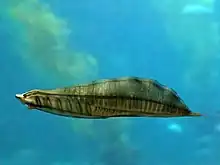Haikouella
Haikouella is an agnathan chordate from the Lower Cambrian Maotianshan Shales of Chengjiang County in Yunnan Province, China. An analysis in 2015 placed Haikouella as a junior synonym of Yunnanozoon, another Maotianshan shale Cambrian chordate.[3][4]
| Haikouella Temporal range: Cambrian Stage 3, | |
|---|---|
 | |
| Artist's restoration of Haikouella lanceolata. | |
| Scientific classification | |
| Domain: | Eukaryota |
| Kingdom: | Animalia |
| Phylum: | Chordata |
| Infraphylum: | Agnatha |
| Family: | †Haikouellidae |
| Genus: | †Haikouella |
| Type species | |
| Haikouella lanceolata Chen, Huang & Li, 1999[2] | |
| Other species | |
| |
It is similar to the form Yunnanozoon,[5] which is possibly a hemichordate.[6] Still, there are anatomical differences from Yunnanozoon, including a larger stomach and smaller (0.1 mm) pharyngeal teeth. Haikouella does not have bones or a movable jaw, but it otherwise resembles vertebrates. Haikouichthys and Myllokunmingia, which seem to share significant fish-like characters, have been found in the same beds. Suspected hemichordates are also known from these deposits as well as from the Middle Cambrian Burgess Shale of British Columbia. Other than possible fish scales/plates from the Upper Cambrian of Wyoming and conodonts, teeth plates of extinct Agnatha, these Chinese fish-like chordates are one of the only known pre-Ordovician craniates.


Haikouella is known from 305 specimens mostly from a single bed in the Maotianshan Shales. The animal is 20 to 30 mm (40 mm max) in length and has a head, gills, brain, notochord, well developed musculature, heart and circulatory system. It has a bent caudal projection of the notochord that might be a primitive tail fin. It might have a pair of lateral eyes. Very small (0.1 mm) structures that are probably pharyngeal teeth are present in the body cavity. A few specimens display dorsal and ventral fins.
There are two known species, the type species, H. lanceolata, and H. jianshanensis.[7]
References
- Yang, C.; Li, X.-H.; Zhu, M.; Condon, D. J.; Chen, J. (2018). "Geochronological constraint on the Cambrian Chengjiang biota, South China" (PDF). Journal of the Geological Society. 175 (4): 659–666. Bibcode:2018JGSoc.175..659Y. doi:10.1144/jgs2017-103. ISSN 0016-7649. S2CID 135091168.
- Chen, J.-Y.; Huang, D.-Y.; Li, C.-W. (1999). "An early Cambrian craniate-like chordate". Nature. 402 (6761): 518–522. Bibcode:1999Natur.402..518C. doi:10.1038/990080. S2CID 24895681.
- Cong, Pei-Yun; Hou, Xian-Guang; Aldridge, Richard J.; Purnell, Mark A.; Li, Yi-Zhen (2015). Smith, Andrew (ed.). "New data on the palaeobiology of the enigmatic yunnanozoans from the Chengjiang Biota, Lower Cambrian, China". Palaeontology. 58 (1): 45–70. doi:10.1111/pala.12117. S2CID 84567733.
- Tian, Qingyi; Zhao, Fangchen; Zeng, Han; Zhu, Maoyan; Jiang, Baoyu (2022-07-08). "Ultrastructure reveals ancestral vertebrate pharyngeal skeleton in yunnanozoans". Science. 377 (6602): 218–222. Bibcode:2022Sci...377..218T. doi:10.1126/science.abm2708. ISSN 0036-8075. PMID 35857544. S2CID 250380981.
- Chen, J.-Y. (2009). "The sudden appearance of diverse animal body plansduring the Cambrian explosion". The International Journal of Developmental Biology. 53 (5–6): 733–751. doi:10.1387/ijdb.072513cj. PMID 19557680.
- Shu, D.; X. Zhang; L. Chin (4 April 1996). "Reinterpretation of Yunnanozoon as the earliest known hemichordate". Nature. 380 (6573): 428–430. Bibcode:1996Natur.380..428S. doi:10.1038/380428a0. S2CID 4368647.
- Shu, D.; Conway Morris, S.; Zhang, Z. F.; Liu, J. N.; Han, J.; Chen, L.; Zhang, X. L.; Yasui, K.; Li, Y.; et al. (2003). "A new species of Yunnanozoan with implications for deuterostome evolution". Science. 299 (5611): 1380–1384. doi:10.1126/science.1079846. PMID 12610301. S2CID 45702564.